The (Real) History of Thanksgiving
Thanksgiving brings families together to share rich meals featuring turkey, stuffing, and seasonal décor like pumpkins and warm autumn colors.
Errika Gerakiti 28 November 2024
This list of queer mythological characters and deities from around the world, encompassing homosexuality, bisexuality, transgender identities, and gender-fluidity, only scratches the surface of the rich history of queer narratives.
In the context of cis-heteronormativity, such ancient characters are striking in their non-conforming expressions of gender and sexuality. However, it is important to note that what we identify as queerness is often symbolic of qualities such as balance and harmony, or conversely, dominance and trickery.
Yet, despite their allegorical significance, queer mythological characters reflect the intricacies of identity and desire, holding up a torch to the boundless parameters of experience and existence. Ultimately, they connect us to a shared humanity reflected throughout ancient belief systems, serving as a reminder of the enduring presence of queerness across cultures.
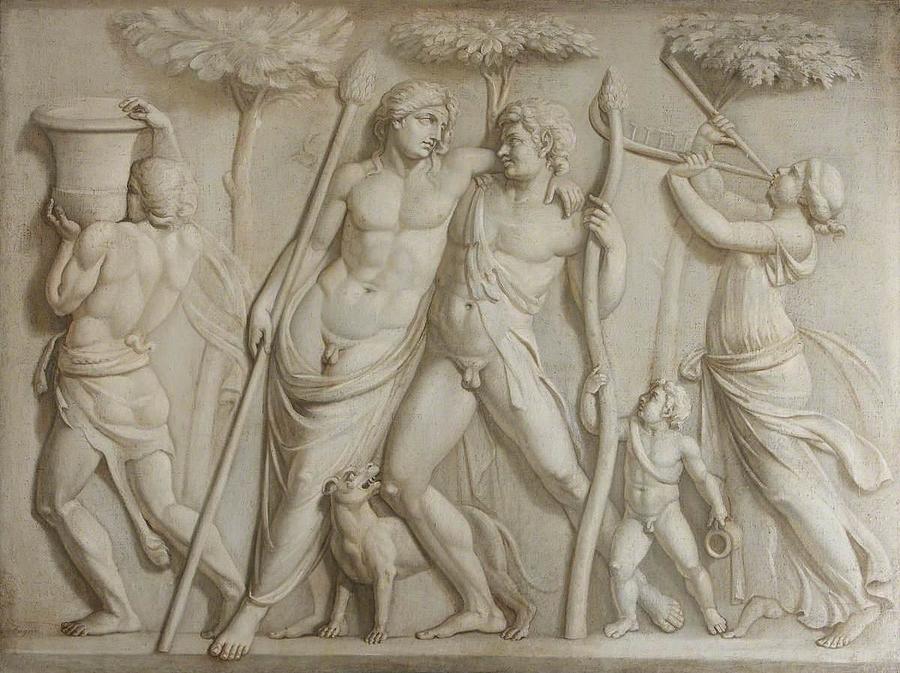
Queer Mythological Characters: Robert Fagan, Dionysus, Ampelos, Silenus and a Maenad, 1793-1795, National Trust, Attingham Park, Shrewsbury, UK.
Greco-Roman mythology is prolific in its explicitly queer mythological characters. There are countless examples of same-sex relationships and queer individuals. The story of Ampelos and Dionysus is a particularly illuminating example of ancient love and the formation of identity.
Ampelos was a beautiful young man with whom the son of Zeus, and bisexual icon, Dionysus, fell madly in love. Ampelos and Dionysus would spend their days together, exploring the forests, swimming, and collecting grapes for wine-making. Ampelos’ death forms the origin story of Dionysus’ iconography of the vine branch.
In Ovid’s version of the story, Ampelos falls from a tree to his death when reaching for a grapevine. Heartbroken, Dionysus cast his body to the stars, forming part of the Boötes constellation. In another version, Ampelos is killed by a bull and Dionysus subsequently transforms him into the first grapevine from which he could make alcoholic wine. In either iteration, Dionysus and Ampelos’ poignant love story is one for the ages.
In the Kingdom of Dahomey, the Fon people wove a rich tapestry of cosmological beliefs interwoven with mythology. Vodun cosmology, formative to the West African and Caribbean pantheon, centers on the Earth’s composition of spiritual elements, from governing forces to the spiritual essence of a tree. At its core stands the creator deity, Mawu-Lisa, symbolizing the divine union of opposites. Born as twins to the androgynous Queen Nana Baluku, Mawu and Lisa merged, giving rise to a singular, bigender deity and the creation of the universe.
Mawu, associated with the feminine moon, and Lisa, associated with the masculine sun, embody the duality of light and darkness, power and intuition, and strength and wisdom, encapsulating the inherent harmony within the natural world. The corporeal manifestation of intersexuality serves as a representation of the fluidity of gender in the divine realm, illustrating the fusion of masculine and feminine energies within the forces of creation.
Whilst Mawu-Lisa serves as a symbol of the cyclical nature of existence and the interconnectedness of opposing forces, West African mythologies reflect a nuanced treatment of gender beyond binary physical forms, embracing androgynous bodies and coalescing spiritual essences. The story of Mawu-Lisa’s becoming can viewed as a profound exploration of the complexities of identity in the balance of earthly existence.
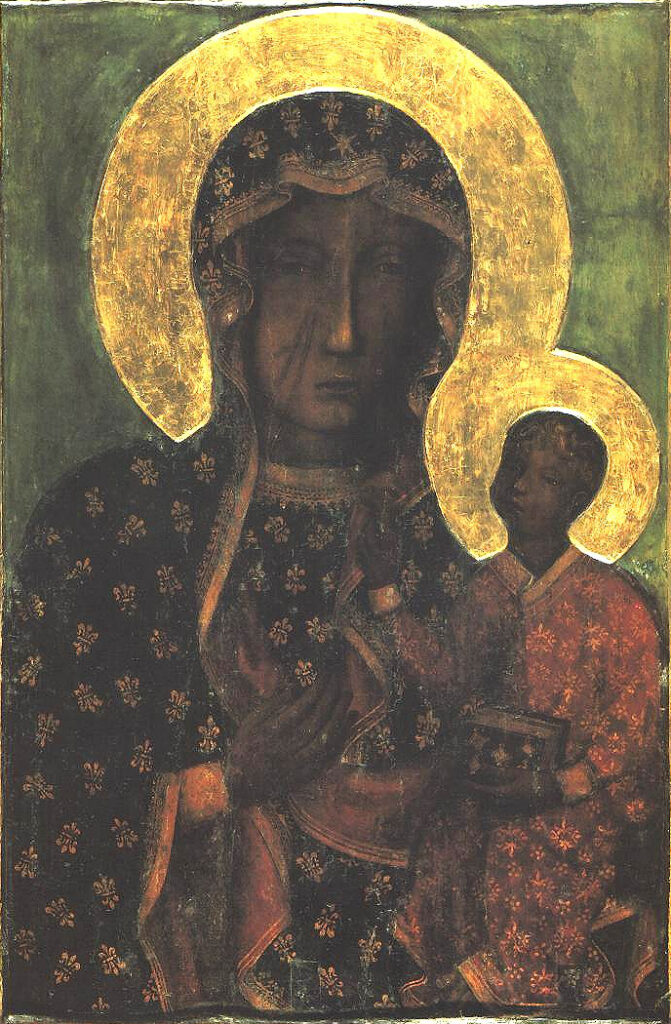
Queer Mythological Characters: Black Madonna of Częstochowa (inspiration typically used in the depiction of Erzulie Dantor), Jasna Góra Monastery, Częstochowa, Poland.
Another queer mythological character from the Vodun pantheon is Erzulie. She emerged in Haitian vodou as a diasporic development of the Yoruban River Goddess, Oshun. The Lwa (spirit) of love, beauty, and sensuality, Erzulie manifests in a range of identities embodying the multifaceted experiences of Haitian womanhood. Her various incarnations, such as Èrzulie Dantòr and Erzulie Fréda, help to protect women from abuse, support them in childbirth, take vengeance on those who have wronged them, bring luxuries, provide nurturing kindness, and seduce people with feminine allure.
In addition to being the guardian of women, Erzulie also protects homosexual men and is often thought of as being bisexual, preferring the company of women. When Erzulie possesses the body of a man, he is liberated to express homoerotic and effeminate tendencies. When she inhabits a woman, she stirs anti-male sentiment and lesbianism. This fascinating and complex family of lwa has evolved to become a symbol of feminine power and queer communities, representing the passions and sorrows intertwined in identities.
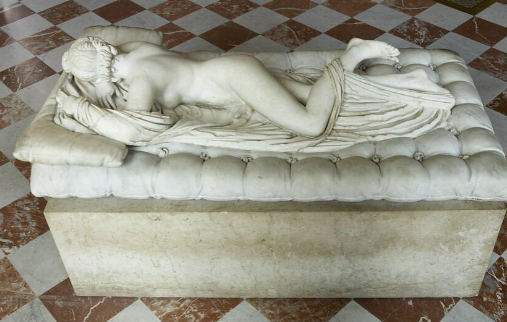
Queer Mythological Characters: Sleeping Hermaphrodite, 150-140 BC, Musée du Louvre, Paris, France.
In his intersex form, the beautiful Hermaphroditus was also loved by Dionysus. Hermaphroditus was born the son of queer Greek deities, Hermes and Aphrodite, who often represent homoerotic love and gender variance. Prior to his transformation, he was adored by a water nymph called Salmacis.
When Hermaphroditus rejected her affections, she prayed to the gods that they would be together in eternal union. The gods answered Salmacis’ prayers that she and Hermaphroditus would never part, but divine intervention took an unexpected turn. When Salmacis caught the young man bathing in a secluded pool, she rushed to embrace him. But her touch caused the two bodies to fuse together, merging to become a singular entity. The union of bodies resulted in Salmacis ceasing to exist and Hermaphroditus developing a partially female form. Often depicted with a feminized body and a penis, Hermaphroditus has come to symbolize the sacred union of sexes, intersexuality, and transformation.
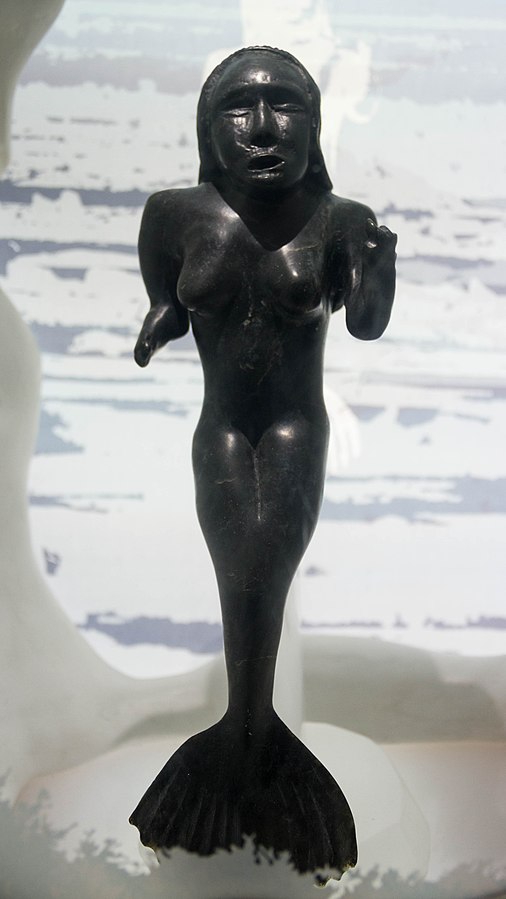
Nuvualiak Alariak, Sedna, Ivujivik, Oceanopolis, Brest, France. Photo by Léna via Wikimedia Commons (CC BY-SA 4.0).
Inuit Mother Goddess, Sedna, served by two-spirit shamans and often considered to be gynandrous, gained her goddess status as the mother of wild sea creatures through tragic means. However, borne from tragedy, she blossomed as the patroness of animals, hunters, and fishers, becoming the goddess of destiny, death, and the afterlife. Her reign covers three heavens of the Inuit, including Omiktu, where the souls of deceased humans and whales live in harmony.
Sedna dwells with her Amazonian female companion, Qailertetang, in the depths of the ocean. Their relationship has been interpreted as lesbian love and female solidarity. This interpretation is supported by the fact that Sedna’s expulsion to the deep sea occurred as a result of her refusal to marry a man, leading her to be abducted by a spirit bird. Afraid to anger the spirits further, her father sacrificed her to the waves.
Sedna’s story marks her as a particularly unique queer mythological character. Her refusal to conform to patriarchal standards of marriage resulted in her immense suffering, yet through overcoming such pain, she develops wondrous power and a harmonious relationship with Qailertetang as the mothers of the ocean and the weather.
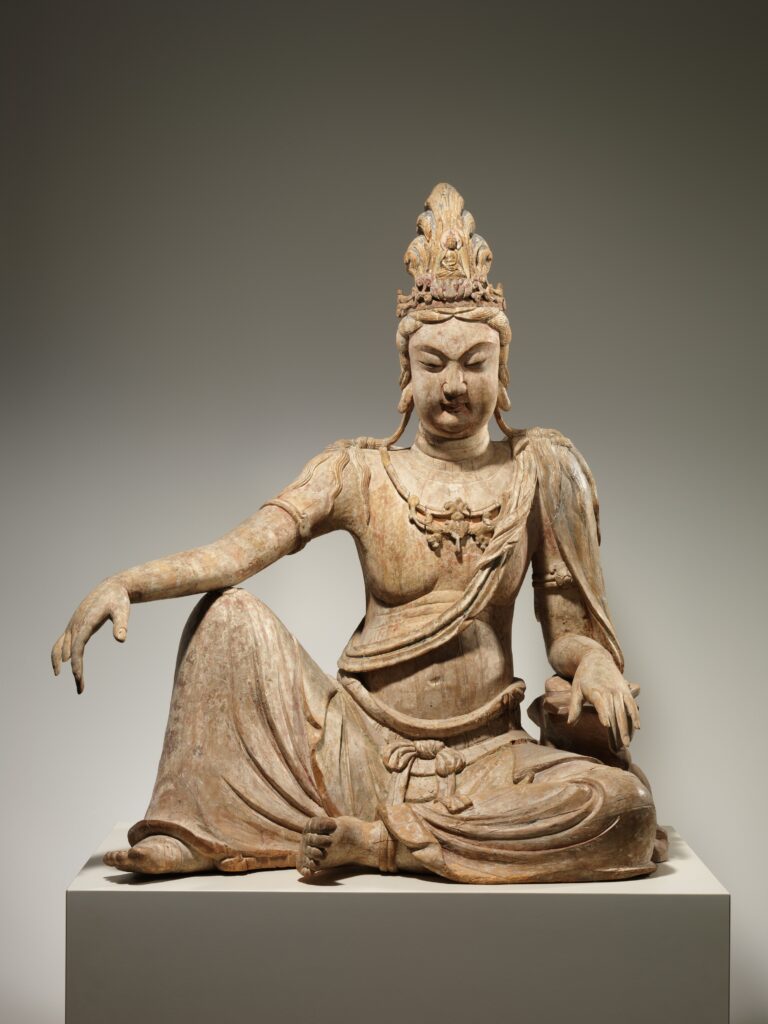
Queer Mythological Characters: Bodhisattva Avalokiteshvara in Water Moon Form (Shuiyue Guanyin), China, 11th century, Metropolitan Museum of Art, New York City, NY, USA.
Chinese Buddhist Bodhisattva, Guanyin (or Kuan-Yin), is the goddess of mercy and compassion who postpones nirvana in order to aid humanity’s spiritual development. Whilst frequently depicted as female, Kuan-Yin has the ability to transform sexes and present as a male. Her story embodies the quest for healing, justice, and helping those who are suffering, particularly women and children.
Initially conceived of as a male, Guanyin was visualized as a female in the 8th century CE as the companion of Buddha, forming the feminine element to the balance of femininity and masculinity achieved through enlightenment. This is through the understanding that Guanyin can assume the most necessary form to aid those in need, notably her male incarnation, Avalokiteshvara. Many Chinese women and transgender communities have revered Guanyin as a figurehead for feminism, lesbianism, asexuality, transgender identities, and spiritual practice, as she not only provides protection but also rejects heterosexual marriage in pursuit of spiritual work. Such an expression of demasculinization, yet also gender-fluidity, marks Guanyin as an important queer mythological character to many people.
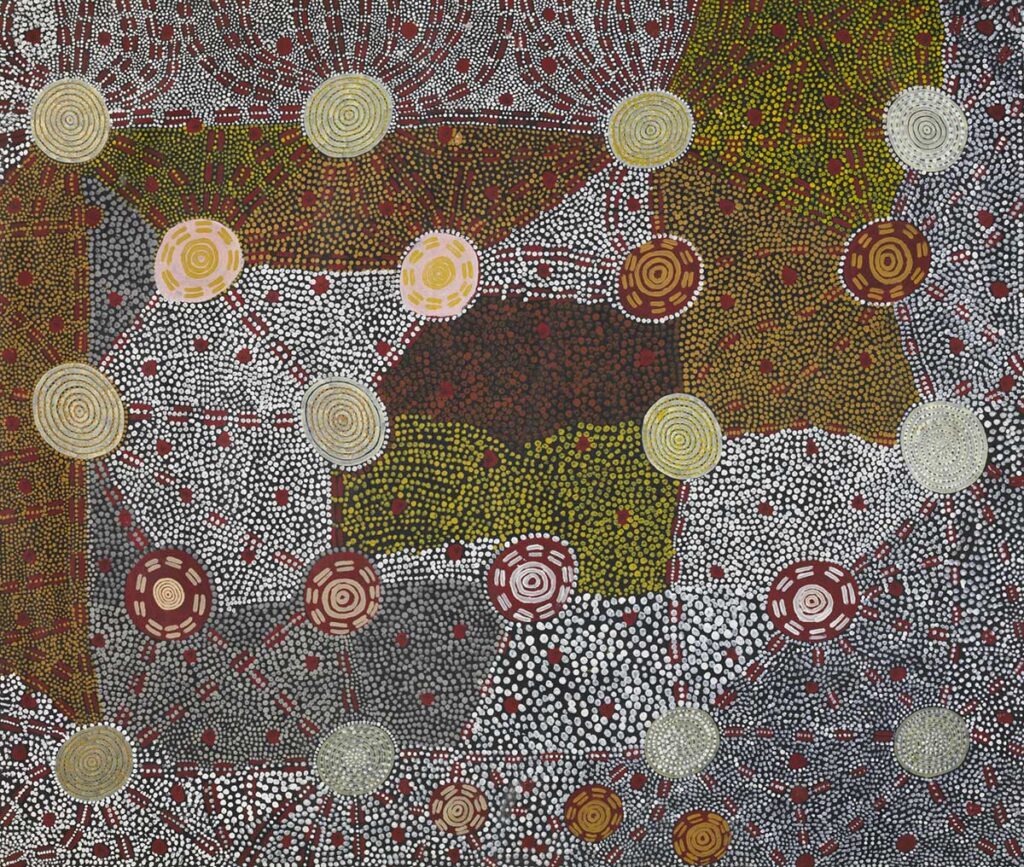
Kaapa Tjampitjinpa, Watunuma, (Warturnuma), (Flying Ant Dreaming), 1976, synthetic polymer paint on canvas, National Museum of Australia, C
The Labarindja, wild women of indigenous Australian folklore, rejected sexual intercourse with men, wanting nothing to do with them romantically. Any man who attempted to force sexual advances would be cursed to death. These powerful asexual women had blue skin and hair the color of smoke. Whilst it is considered that their vaginas contained their protective dark magic, some are noted to have had both a penis and vagina. In ritual, the labarindja are depicted as gynandrous and often performed by men in women’s attire.
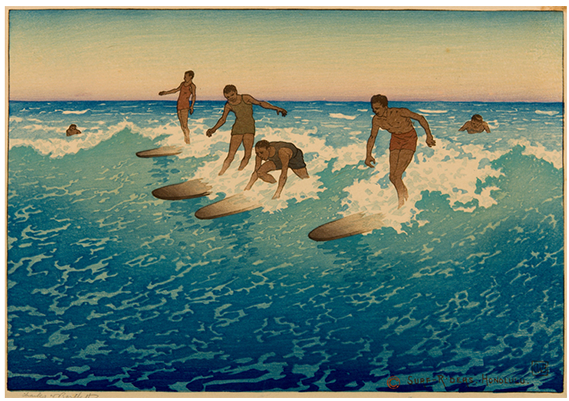
Charles W. Bartlett, Surf-Riders. Honolulu, c. 1919—1920, Honolulu Museum of Art, Honolulu, HI, USA.
In the Kanaka Maoli culture, indigenous to the islands of Hawaii, gender diversity is interwoven into mythology and identity, with three recognized and celebrated genders. These are known as kane (men), wahine (women), and māhū, the middle gender. This cultural framework acknowledges and honors the presence of māhū individuals, who represent the balance between traditional masculine and feminine expressions. Rather than adhering to rigid binary classifications, the Kanaka Maoli people recognize the fluidity and interconnectedness of gender, viewing māhū as an integral part of the communal fabric, with māhū individuals contributing a unique and valued perspective to the community.
The narrative follows that many generations ago, the shores of Hawaii welcomed the arrival of four extraordinary Pacific Island spirits: Kapaemāhu, Kapuni, Kīnohi, and Kahaloa. These revered beings were māhū, embodying the delicate yet potent essence of gentle yet powerful healers. In the sacred triad of mind, heart, and spirit, these spirits harmoniously blended both male and female qualities.
The presence of Kapaemāhu, Kapuni, Kīnohi, and Kahaloa on the Hawaiian islands was marked by their peaceful demeanor and their remarkable healing abilities. Their energies resonated with balance, radiating a serene and nurturing force that endeared them to the local people. The māhū quartet moved among the communities, offering solace and restoration to those in need, leaving behind a legacy of kindness and compassion.
As the time for their departure approached, the Hawaiians, overwhelmed with gratitude, sought to express their deep appreciation for the benevolent spirits. In a gesture of reverence, they crafted a sacred site composed of four colossal boulders. Each stone represented one of the māhū healers: Kapaemāhu, Kapuni, Kīnohi, and Kahaloa. This monumental gift served as a testament to the enduring impact of the spirits’ presence and the enduring connection between the earthly realm and the divine.
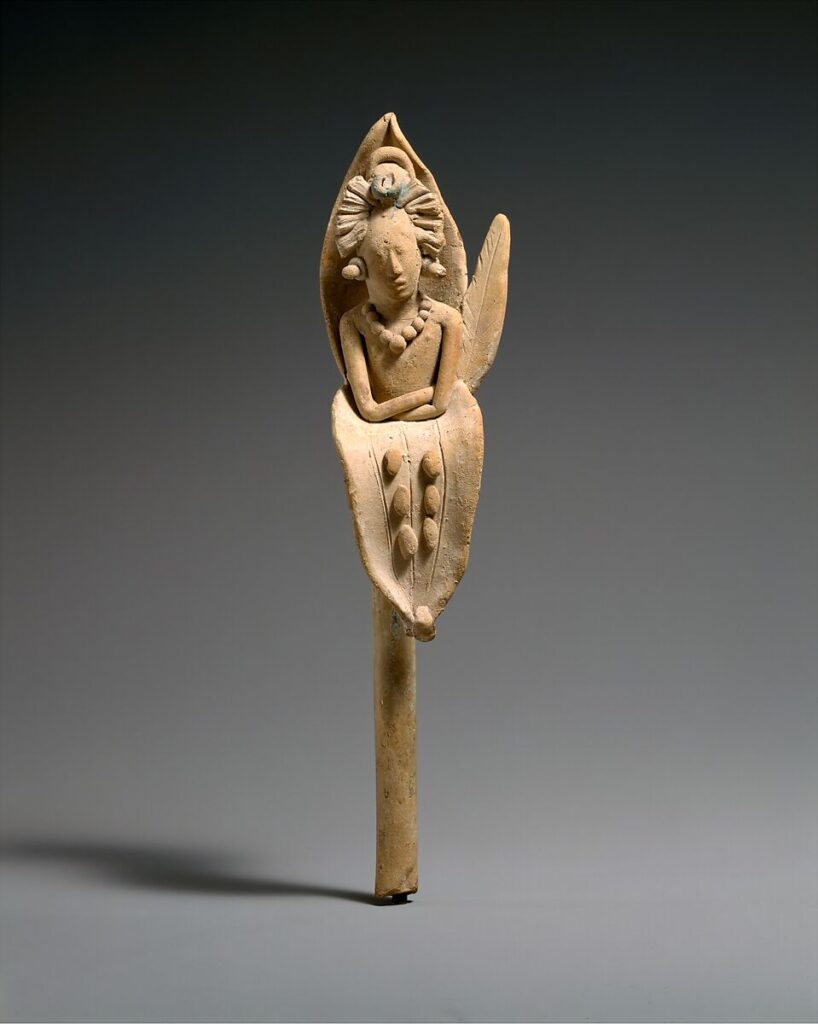
Queer Mythological Characters: Maize God Emerging from a Flower, 7th-9th Century, Mesoamerica, The Metropolitan Museum of Art, New York City, NY, USA.
Mayan deity, Chin (or Chen) is the god/goddess of nurturance, maize, magic, divination, and the destinies of rulers, often depicted in either male or female forms. Associated with same-sex eroticism and homosexuality, they are said to have introduced the Mayas to homosexual practice, resulting in Mayan nobles encouraging their sons to marry handsome young men.
Randy P. Conner, David Hatfield Sparks, Mariya Sparks. Cassells Encyclopedia of Queer Myth, Symbol, and Spirit: gay, lesbian, bisexual, and transgender lore, (1998), Cassell, London
DailyArt Magazine needs your support. Every contribution, however big or small, is very valuable for our future. Thanks to it, we will be able to sustain and grow the Magazine. Thank you for your help!